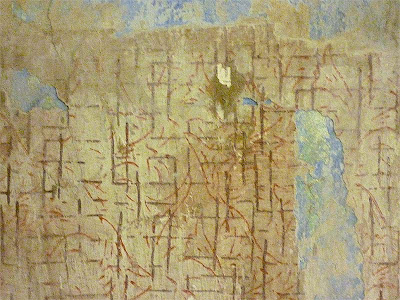An excellent trip last week, to the Pitt Rivers Museum and the Oxford University Museum of Natural History. Neighbouring but entirely separate entities, with contrasting taxonomies. Apparently, originally, there was an intent to demonstrate a social Darwinism in the Pitt Rivers, by juxtaposing objects of common function from 'primitive' and 'advanced' cultures. The net effect is opposite, with beautiful examples of the symbiosis of available materials and requisite making. I always return to the cabinets containing object–systems for writing and counting.
These West African Oroko and other symbolic systems, communicate personal insults, calls to battle, requests for foodstuffs, news of death, bids for friendship. The number and orientation of cowrie shells denotes an array of meanings, as described here. The intrinsic character of a cowrie is human and therefore connotes a human situation. Where they face away from one another they really are facing away. Elsewhere, knotted string gives the intuitive property of distance and space to travel.

I reflected afterwards (in the light of messages and matter) on another trip, back in September and in Berlin. The Museum of Otto Weidt's Workshop for the Blind is the original site, where around thirty blind and deaf Jews were employed—and therefore shielded from internment—by Weidt to make brushes and brooms in the early 1940s. Under constant threat, they hid within concealed spaces in the workshop and Weidt obtained false identities (as above, for Marianne Bernstein) and bribed Gestapo officials; any means to stave off the inevitable.
The museum has humility, weighted only by the original nature of the spaces and the stories of individuals who, in the majority were killed and the exceptions who survived. This is the recto and verso of a postcard, thrown from an Auschwitz–bound transportation train by Alice Licht and addressed to Otto Weidt in the remote hope of it finding him, which it did. Somebody picked it up and sent it on.

Alice parents were killed in Auschwitz. She was later transported to Groß–Rosen. Weidt managed to make contact and organised a safe hiding place in Berlin, to which she fled during an evacuation in 1945. She emerged few weeks later, surviving the war and then emigrating to the US. She died in 1987.
This poem, Zurück–Glück (Return–Happiness), written after her escape in April 1945.
Beyond the stories, the walls within the hidden spaces.
Walter Benjamin: "To articulate the past historically does not mean to recognize it ‘the way it really was’ (Ranke). It means to seize hold of a memory as it flashes up at a moment of danger".
A certain resonance in straightforward effects and documentation, telling a human tale. Perhaps the gap to think. The frankness of a factual item. Christian Boltanski has referenced and used as a raw material, the emotional impact of piles of clothes belonging to those deported, discovered in the Nazis' storage warehouses. The specificity of belongings, indicating an individual's life, over the anonymity of a naked body. This piece, Inventaire des Objets Ayant Appartenu a une Femme de Bois-Colombes (1974), from a series of five (I think) bookworks which fully documented the belongings of a woman living in a suburb of Paris.
At no stage do we see an image, a likeness of the woman. Only her taste in books. Which tells a greater truth?
Back to the Pitt Rivers and some more from the Writing & Counting cabinet.
Nearby, a cabinet displaying scrimshaw and other notchmaking, markmaking in bone. An object behaving as a page.



















1 comment:
i haven't seen a thoughtful, well-written post about such interesting objects/people/histories in a long long long time. thank you for caring so much about what you write and for sharing it so articulately!!!
Post a Comment